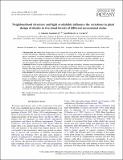| dc.contributor.author | Guzmán Quesada, Jose Antonio | |
| dc.contributor.author | Cordero, Roberto | |
| dc.date.accessioned | 2020-05-25T23:07:11Z | |
| dc.date.available | 2020-05-25T23:07:11Z | |
| dc.date.issued | 2016-07 | |
| dc.identifier.uri | http://hdl.handle.net/11056/17414 | |
| dc.description.abstract | Background and Aims Plant design refers to the construction of the plant body or its constituent parts in terms of form and function. Although neighbourhood structure is recognized as a factor that limits plant survival and species coexistence, its relative importance in plant design is not well understood. We conducted field research to analyse how the surrounding environment of neighbourhood structure and related effects on light availability are associated with changes in plant design in two understorey plants (Palicourea padifolia and Psychotria elata) within two successional stages of a cloud forest in Costa Rica. Methods Features of plant neighbourhood physical structure and light availability, estimated using hemispherical photographs, were used as variables that reflect the surrounding environment. Measures of plant biomechanics, allometry, branching and plant slenderness were used as functional plant attributes that reflect plant design. We propose a framework using a partial least squares path model and used it to test this association. Key Results The multidimensional response of plant design of these species suggests that decreases in the height-based factor of safety and increases in mechanical load and developmental stability are influenced by increases in maximum height of neighbours and a distance-dependence interference index more than neighbourhood plant density or neighbour aggregation. Changes in plant branching and slenderness are associated positively with light availability and negatively with canopy cover. Conclusions Although it has been proposed that plant design varies according to plant density and light availability, we found that neighbour size and distance-dependence interference are associated with changes in biomechanics, allometry and branching, and they must be considered as key factors that contribute to the adaptation and coexistence of these plants in this highly diverse forest community. | es_ES |
| dc.description.sponsorship | Universidad Nacional, Costa Rica | es_ES |
| dc.language.iso | eng | es_ES |
| dc.publisher | Annals of Botany | es_ES |
| dc.rights | Acceso abierto | es_ES |
| dc.source | J. Antonio Guzman Q, and Roberto A. Cordero. 2016. . Neighbourhood structure and light availability influence the variations in plant. -- Costa Rica; Annals of Botany 118: 23–34, | es_ES |
| dc.subject | Economic plant design | es_ES |
| dc.subject | Palicoureapadifolia | es_ES |
| dc.subject | Plant allometry | es_ES |
| dc.subject | Plant biomechanics | es_ES |
| dc.title | Neighbourhood structure and light availability influence the variations in plant design of shrubs in two cloud forests of different successional status | es_ES |
| dc.type | http://purl.org/coar/resource_type/c_6501 | es_ES |
| dc.description.procedence | Escuela de Ciencias Biológicas | es_ES |

